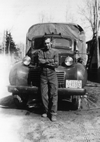12. Lehigh Row
MASON CITY WAS A TOWN SURROUNDED BY CORN, halfway between Des Moines and Minneapolis and readily accessible to neither. With about 17,000 people, the town was a metropolis compared with Farindola. But Serafino and Maria didn’t see much of the town. The Lehigh Portland Cement Company quarry and housing, situated about half a mile north of the rest of town, functioned like a town unto itself.
The Lehigh housing consisted of five rows of wood frame duplexes—19 buildings containing 38 homes. Most of the homes housed large immigrant families. A few of the homes housed up to 20 single immigrant men who shared beds by working opposite 12-hour shifts. At one time in the teeming neighborhood, the 38 homes housed nearly 400 people, composed of roughly 300 family members and 100 single men. The vast majority of the people came from Southern Europe, Eastern Europe, and Mexico.
The neighborhood included a separate row of stores for the workers and families. There was a grocery, a bakery, a meat market, a barbershop, a barbeque, and a pool hall. The homes and stores straddled a solitary gravel road that became known as Lehigh Row.
Each home was built the same. Although austere, it was more luxurious than anything Maria had ever imagined. The downstairs had two rooms. The big room was a living room, dining room, and kitchen combined. The small room was a bedroom. A cast iron cook stove in the big room heated the downstairs. A staircase separated the two rooms and led upstairs to an enormous U-shaped open space, which was heated by a coal-burning potbelly stove. One light bulb hung from the ceiling on each floor.
“Heat and electricity!” Maria marveled.
The furnishings were sparse. The cook stove commanded the front of the big room downstairs. A rickety China cabinet stood at the back. A plain round table and chairs sat in the middle. The kitchen area had a shelf, a sink, a dipper, washboards, and two water basins: one for drinking and cooking, the other for washing dishes, clothes, and people. Upstairs, several steel cots lined each side of the staircase. Each cot had a metal spring and a three-inch mattress. Upstairs and downstairs, the floors were made of the kind of coarse wooden planks that gave people splinters if they didn’t wear socks.
There was no indoor plumbing. Water pumps had been dug out front between the homes. There was one pump for every four homes.
The two homes in each duplex were built side-to-side. Each home had a small garden on the unattached side and another small garden in the back. People grew vegetables wherever they could find a spare scrap of land. White pebbly gravel covered the remaining spaces of land between the rows of duplexes.
Each home had its own outhouse. The outhouses were also duplexes. They straddled the adjoining back yards. Once a year, the “honey man” came to Lehigh Row to clean the outhouses and to transform their contents into fertilizer for the gardens. Honey for the soil.
The cement company gave each home an additional plot of soil in a community garden a few hundred yards from the homes. Each plot came with its own chicken coop.
Each home also had a front porch and a small dirt-floored basement. Beneath the frame of each home, there were tiny crawl spaces where the chickens stayed warm during the winter. Outside each home, there was a coal shed attached to the building.
Everything was painted gray.
Lehigh Row was a world apart from its Middle American surroundings. It was far enough removed from the rest of town to shield the immigrants from the broader community and vice versa. Mason City proper, with its growing network of paved streets and an expanding sewer system, ended abruptly at the northern edge of the city at 17th Street. The next road north, half a mile further up the highway toward Minneapolis, was technically 25th Street. But everyone in town knew that 25th Street was Lehigh Row. It was that separate place, eight phantom blocks away, hidden by the corn.
